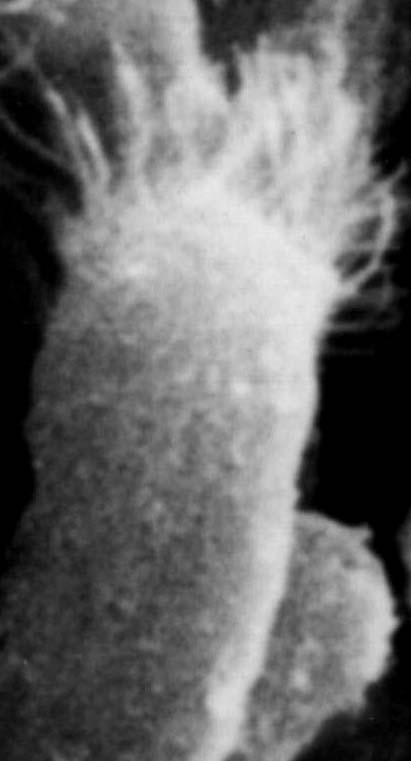Dr. Grossan's Ear, Nose and Throat Consultant Pages
Sinus Disease & Problems explained
Why Do We Have Sinuses? - The Healthy Sinus
The sinuses are cavities, basically empty space, in your head. While the empty
spaces might have no more purpose than to make our heads lighter and easier to
move, the lining of the sinuses provide an absolutely essential function: They
protect the body from dust, pollen, other types of foreign matter, and germs in
the air we breathe.
The sinuses are lined with a mucous membrane, soft, moist tissue covered with a layer of mucous. The surface tissue is densely covered with microscopic hair-like cilia.

Electron micrograph of a human nasal cilia. Click on the image for a full-size picture.
CAUTION: VERY LARGE AND SLOW TO LOAD
The cilia wave back and forth, moving the mucous, and the pollen, germs, and irritants
caught in it, around the sinuses until they are flushed out to the stomach via
the back of the throat. This is the way your body prevents bacteria from entering
the body while you are breathing through your nose; proper cilia action is essential
for your health.
A diagram of the sinuses and an explanation is given here if you want to learn the names and see the locations of the different sinus cavities( frontal, maxillary, ethmoid, and sphenoid). This might be helpful, for example, to understand a doctor's diagnosis or your X-ray.
Sinusitis
Thirty-five million people in US have sinusitis, but few people understand sinus
diseases, its causes, and the range of treatments available. Sinusitis refers
to any kind of inflammation or irritation of the sinuses. This is typically
caused by bacterial infections. Since the sinuses connect directly with the nose,
usually the main signs of a sinus infection are a stuffy nose and drainage from
the nose. The reason that sinusitis can be so debilitating, and why it can become
serious when complications occur, is that sinus infections weaken the body's mechanism
for keeping away more infection - the cilia. The worse your sinuses get, the worse
your sinuses get, until treated. Your very breathing is dependent on clear sinuses,
making sinusitis particularly unpleasant.
Sinusitis is usually caused by bacteria, especially S.pneumoniae, H. influenzae
and M. catarrhalis. Your doctor may take a culture to determine which bacteria
is present, so he or she can figure out how to fight your infection. When the
sinuses are blocked, the result is a good environment for infectious bacteria
to live. Healthy sinuses have cilia that move bacteria out of the sinus fast
enough that bacterial growth cannot occur. However, if the cilia don't beat
fast enough due to a bad cold or flu, or if the sinus drainage is blocked, infection
will result.
In patients with immune system disorders including AIDS, fungus organisms
are sometimes found to cause a sinus infection.
Complications
A bad abscess in the frontal sinuses can drill through the bone and come out above
or into the eye.
In extreme cases of sinus infection, the infection can spread and do horrible
things - they can even infect the brain. These conditions are rare, however,
and most patients with serious infections respond to antibiotics. This treatment
has the drawback of making patients immune to antibiotics; other infections
later in life could become serious while the doctor is searching for an antibiotic
that the infection has no immunity to. For some types of sinus problems, surgeries
can be effective, but they have complications. That's why prevention and early
treatment of infection with pulsatile irrigation is the better option.
Treatment
Prevention -
Be very gentle on blowing your nose
Move away from people who are coughing and sneezing.
It is important to get a good night's sleep when you have a cold.
Use pulsatile nasal irrigation to remove yellow
mucus and help the natural defense of the body - the cilia - do their job.
After you get sinusitis
Always consult your doctor.
Use hot compresses to the sinus area.
Drink lots of hot tea and chicken
soup. Rest and relax.
Use Pulsatile Irrigation daily.
More Information on Sinusitis Topics
The Sinus Cavities (Sinus Anatomy 1)
Your head has a cavity, the nasal cavity, which connects directly to the nose, but is not part of the sinus. The important stuff, the cilia, are in the four sinuses, which each have left and right halves -
Frontal Sinuses - above your eyes, just behind the forehead.
Maxillary Sinus - to the side of the nose, and below the eye, just above
the upper teeth, below the eyes and in back of the nose at the top of the throat.
Ethmoid Sinus - between the eyes (actually within the spongy ethmoid bone).
Sphenoid Sinus - WAY back in the head, far behind the eyes, above the throat (in back of the nasal cavity). This sinus is just forward of the brain case, making complications here quite serious.


The sinuses are lined with a (respiratory) covering which is
coated with mucous. The cilia move the mucous around to flush out foreign bodies and germs.
 Back
to The On-Line ENT-Consultant Home Page
Back
to The On-Line ENT-Consultant Home Page
Last Update 2003 October 1
Murray
Grossan M.D.
ENTconsult@aol.com




 Back
to The On-Line ENT-Consultant Home Page
Back
to The On-Line ENT-Consultant Home Page